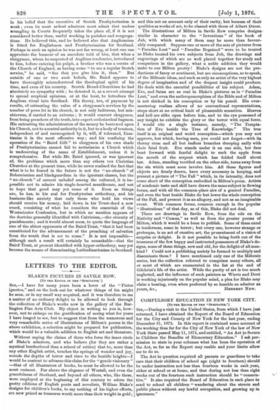LETTERS TO THE EDITOR.
BLAKE'S PICTURES IN SAVILE ROW.
[To THE EDITOR OF THE "SPECTATOR.' ] have for many years been a lover of the "Pictor ighotus," and on the look-out for whatever things of his might be seen, or in my small way acquired, and it was therefore to me a matter of no ordinary delight to be allowed to look through the collection of Blake's works now in the gallery of the Bur- lington Fine Arts Club. My object in writing to you is, how- ever, not to enlarge on the gratification of seeing what for years T have longed to see, but to suggest that from the numerous and very remarkable series of illustrations of Milton's poems in the above exhibition, a selection might be prepared for publication, which would be a valuable addition to English art and literature.
Without urging the claims of those who form the inner circle of Blake's admirers, and who believe (for they are rather a mystical brotherhood than a school of critics) that he, more than any other English artist, touches the springs of wonder and joy, sounds the depths of terror and rises to the beatific heights—I would be content to advance this claim for the " gentle visionary " —that of all illustrators of books, he must be allowed to be the most eminent. Far above the elegance of Westall, and even the gracefulness of Stothard, and beyond all others, who, like these, were employed at the beginning of this century to adorn the pretty editions of English poets and novelists, William Blake's designs for children's books, to say nothing of his higher efforts, are now prized as treasures worth more than their weight in gold ; and this not on account only of their rarity, but because of their qualities as works of art, to be classed with those of Albert Diirer.
The illustrations of Milton in Savile Row comprise designs. similar in character to the " Inventions " of the book of Job, with which many of them may be more than favour- ably compared. Suppose one or more of the sets of pictures from " Paradise Lost " and " Paradise Regained " were to be treated as Blake treated his own subjects from Job, the drawings and engravings of which are so well placed together for study and comparison in the gallery, what a noble addition they would make to our Milton poetry ! Blake's designs are not the pro- ductions of fancy or sentiment, but are reconceptions, so to speak, of the Miltonic ideas, and such as only an artist of the very highest degree of imagination and of the deepest insight could produce. He deals with the essential possibilities of his subject. Adam, Eve, and Satan are as real in Blake's pictures as in " Paradise Lost," and even the anthropomorphism of the Bible and of Milton is not shirked in his conception or by his pencil. His over- mastering realism allows of no conventional representations, stops short at no critical limit of pleasurable sensation. Heaven and hell are alike open before him, and to the eye possessed of any insight he exhibits the glory or the terror with equal force. I would cite a single instance, namely, " The Tempta- tion of Eve beside the Tree of Knowledge." The tree itself is an original and weird conception—which you may not approve, but which, having seen, you could not forget—with its thorny stem and all but leafless branches drooping sadly with their fatal fruit. Eve stands under it on one side, her face bent forward with fearful delight to suck the apple from the mouth of the serpent which has folded itself about her. Adam, standing terrified on the other side, turns away from the sin which must soon involve him. All these figures and objects are firmly drawn, have every accessory in keeping, and present a picture of "The Fall " which, in its intensity, does not come short of the conception embodied in Milton's poem. Artists of academic taste and skill have drawn the same subject in flowing forms, and with all the common-place airs of a genteel Paradise, and even the best beside Blake do but lower the whole conception of the Fall, and present it as an allegory, and not as an imaginable event. With common forms, common enough in the popular " illustrations " of that day, as of this, Blake did not deal.
There are drawings in Savile Row, from the ode on the Nativity and " Comus," as well as from the greater poems of Milton, which it would be a boon to publish. Some of them excel in tenderness, some in terror ; but every one, however strange or grotesque, is an act of creative art, the presentment of a vision of surprise or delight. Is it not possible to bring forth out of the treasures of the few happy and instructed possessors of Blake's de- signs, some of these things, new and old, for the delight of all man- kind ? Could not a publishing society be formed to multiply and disseminate them? I have mentioned only one of the Miltonic series, but the collection referred to comprises many others, all or most of which are enumerated in the list at the end of Gilchrist's life of the artist. While the purity of art is too much neglected, and the influence of such painters as Wiertz and Dori is working injuriously on the popular mind, a plea for Blake may claim a hearing, even when preferred by so humble an admirer as


































 Previous page
Previous page